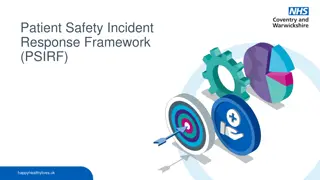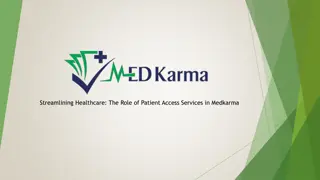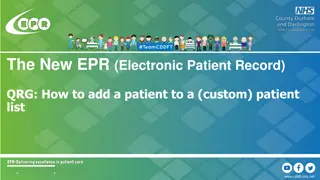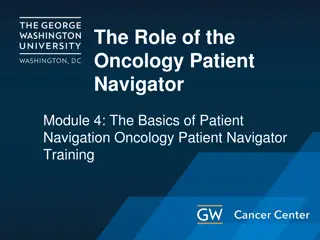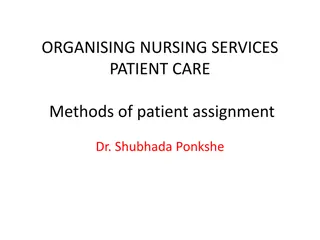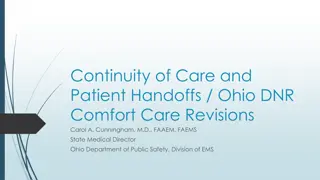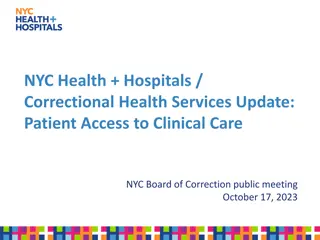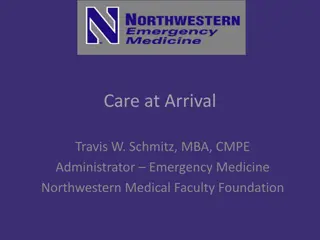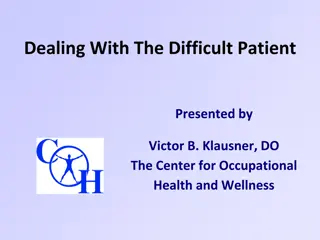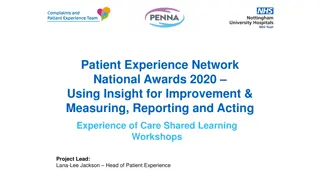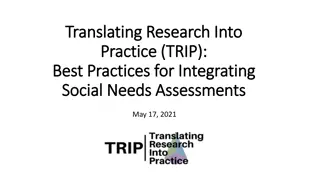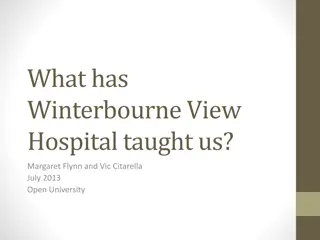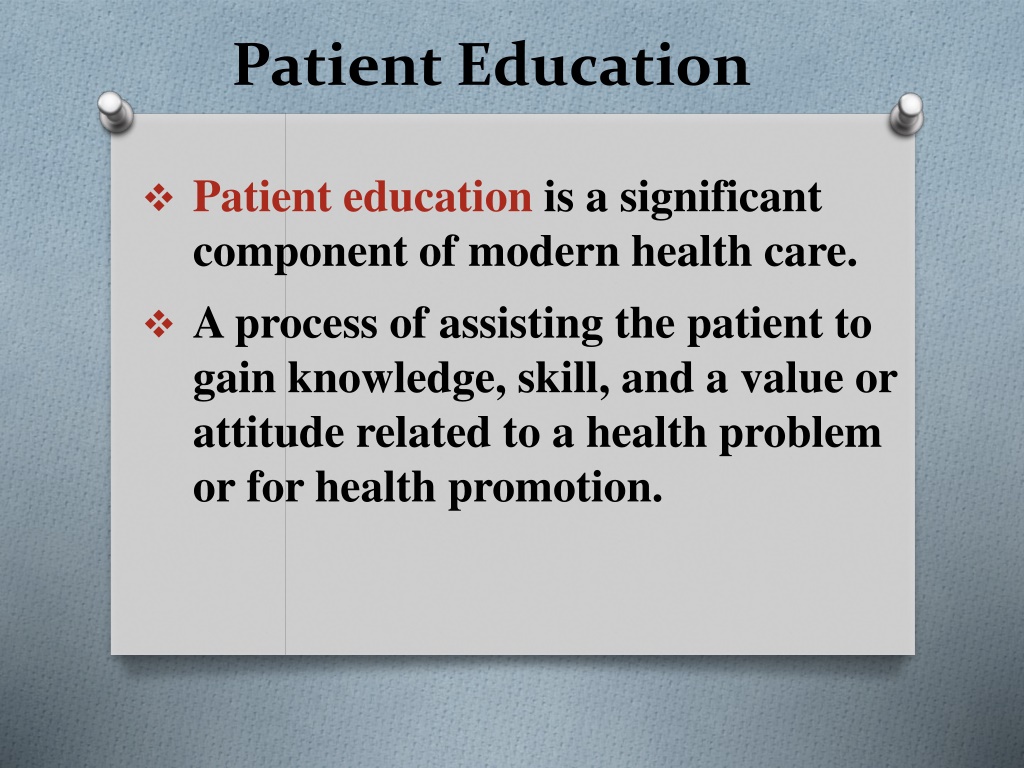
Understanding the Importance of Patient Education in Healthcare
Patient education plays a crucial role in modern healthcare, empowering patients to gain knowledge, skills, and attitudes towards addressing health issues and promoting well-being. It encompasses both clinical patient education and health education, focusing on teaching, learning, and improving health behaviors for positive outcomes.
Download Presentation

Please find below an Image/Link to download the presentation.
The content on the website is provided AS IS for your information and personal use only. It may not be sold, licensed, or shared on other websites without obtaining consent from the author. Download presentation by click this link. If you encounter any issues during the download, it is possible that the publisher has removed the file from their server.
E N D
Presentation Transcript
Patient Education Patient education is a significant component of modern health care. A process of assisting the patient to gain knowledge, skill, and a value or attitude related to a health problem or for health promotion.
Patient Education Patient education can be divided into two large categories clinical patient education (or clinical teaching and learning) and health education. Clinical patient education is a planned, systematic, sequential, and logical process of teaching and learning provided to patients and clients in all clinical settings.
Patient Education Clinical patient education is also a continuous teaching and learning process involving the health care provider and the patient or client (and/or the patient s family). The goals of clinical teaching and learning are based on the patient s assessment, evaluation, diagnosis, prognosis, and individual needs and requirements related to interventions.
Patient Education Health education is also a teaching and learning process similar to patient education. However, it concentrates mostly on wellness, prevention, and health promotion. Additionally, health education can be provided to individuals, groups, and communities. The basic focus of health education is to change and improve societal health behaviors.
Patient Education Patient education The are three important objectives of patient education that may result in positive health outcome. Changing health behaviors Improving health status Improving patient compliance
Patient Education Patient education provides health information and instruction to help patients learn about specific or general medical topics. Topics include the need for preventive services, the adoption of healthy lifestyles, the correct use of medications, and the care of diseases or injuries at home.
Patient Education Patient education Skill Building and Responsibility Patients need to know when, how, and why they need to make a lifestyle change Group Effort Each member of the patient s health care team needs to be involved
Patient Education Patient education Patient Education Value is the results of clear communication Increased Compliance Effective communication and patient education increases patient motivation to comply Patient Outcomes Patients more likely to respond well to their treatment plan which results in fewer complications
Patient Education Patient education Informed Consent Patients feel you ve provided the information they need to make the right decision Utilization More effective use of medical services fewer unnecessary phone calls and visits. Satisfaction and referrals Patients more likely to stay with your practice and refer other patients.
Patient Education Rationale Model of Patient Education Outcomes Health Status Physical health Well-being Symptoms Complications Knowledge and Attitude Changes Increased understanding Increased confidence Increased satisfaction Improved emotional state Patient Education Print Verbal Multimedia Combination Costs Length of stay Utilization Provider image Regulatory compliance Behavior Changes Health services utilization Compliance Lifestyle Self-care
Patient Education - Steps 1. Assessment of the Patient Define patient and family needs and concerns; observe readiness to learn. 2. Design of the Instruction Plan Set objectives with your patient; select materials. 3. Select a Teaching Strategies and resources Put the plan in motion; help patients along the way to reach the objectives you ve set together. 4. Go teach the patient Understand and adapt to barriers to learning 5. Evaluate - Evaluation is critical and should be continuous through all four steps!
Patient Education Step 5: Evaluate Learning Process Step 1: Assessment of the Patient Step 2: Design of the Instruction Step 4: Go teach the patient. Step 3: Select a Teaching Strategies and resources Stromberg A. Eur. J. Heart Failure. 2005.
Patient Education - Steps Assessment of the Patient Define patient and family needs and concerns; observe readiness to learn. Motivation Patients are motivated when they learn how their lives could improve. Focus on the benefits of education. Attitude Denial, Fear, Anger, Anxiety all could be barriers to education. Patient must know that he or she will make gains by learning new skills. Outlook A patient s beliefs about their situation could effect education. Let them know that learning new skills can help them feel better or slow disease progression.
Patient Education - Steps Design of the Instruction Plan Set objectives with your patient; select materials. Goals should focus on what is necessary / critical to patient survival first. Pay attention to patient concerns they could stand in the way of progress Respect stated limits if a patient has refused to do something, try to work around the problem and incorporate something new as best you can. Helping a Patient understands the need for changing behavior
Patient Education - Steps Select a Teaching Strategies and resources Put the plan in motion; help patients along the way to reach the objectives you ve set together. Providing a Good Learning Environment Tone of voice, eye contact, and touch vary for all cultural backgrounds Use the knowledge you gained during assessment Mixing Education Media Choosing the right patient education materials
Patient Education - Steps 1. Go teach the patient Understand and adapt to barriers to learning Let your patients know: What they should do and why When they should expect results Possible danger signs to watch for What they should do if problems arise Whom they should contact for referrals Ask the patient if they have any questions or concerns
Patient Education - Steps Evaluate - Evaluation is critical and should be continuous through all four steps! Getting Patient Feedback Feedback from the patient and family provides valuable perspective on the effectiveness of patient education Consider surveys, documents for patients to sign, questionnaires


